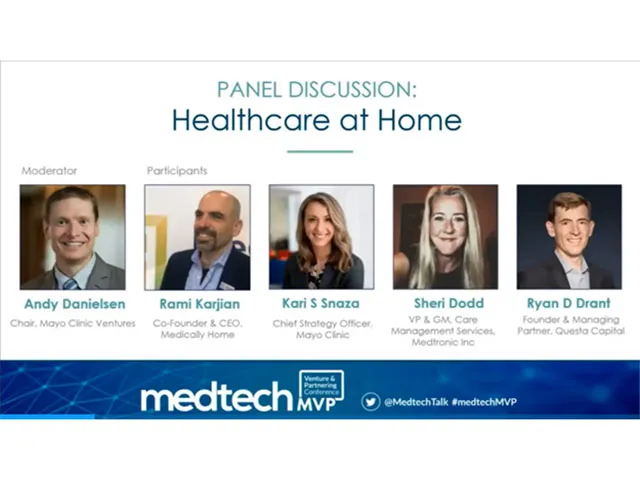Medically Home’s cofounder and CEO, Rami Karjian was honored to have been featured at this month’s #medtechMVP event alongside industry leaders Kara S. Snaza, chief strategy officer, Mayo Clinic; Sheri Dodd, VP & GM, Care Management Services, Medtronic, Inc.; and Ryan D. Drant, founder & managing partner, Questa Capital; for the Virtual Hospital panel, moderated by Andy Danielsen, chair, Mayo Clinic Ventures.

A recording is linked here, the panel discussion begins at timestamp 1:07:20 – Some takeaways include:
- Ryan D. Drant: I think medical devices, medical technology has a huge [role] to play in what we’re doing, in fact it’s really enabled everything that we’re doing and that companies like Medically Home are. I think if you look back 10-20 years, to take care of these patients you needed very expensive large equipment, you had to do imaging in a hospital, you didn’t have the technology infrastructure to monitor these patients and really all of these things have come to the fore in the last 5-10 years so things like more complex point of care diagnostics, point of care ultrasound…we’re believers that the time is right for this to happen and it really couldn’t until very recently.
- Kari S. Snaza: To share the Mayo Clinic perspective and contextualize it, we’ve scaled virtual hospital for high acuity care across all of our sites, we’ve seen over 2,000 patients to date and this year it will be 8% of our inpatient admissions and for next year we’re targeting taking that to 20%…
- Rami Karjian: What’s so intriguing about telehealth, particularly high acuity serious and complex care at home is that we can tap into workforces that we previously haven’t been able to – couple of examples: nurses in the community who today are not being used to provide hospital-level care who we can train-up…another example of that is paramedics – we have a large group of paramedics that are used to emergent, very sick patients, that for the most part we’re unable to use them to provide hospital-level care so now with virtual hospitals and decentralizing care out of institutional sites, we tap into new labor pools at a time when our country needs this better capacity to provide better hospital level care outside of institutional settings.
- Rami Karjian: If you can treat those really sick patients, that’s where you unlock patient satisfaction, clinician satisfaction and the economics and if you created a chassis that could care for those really sick patients leveraging technology, leveraging logistics into the home, it was easy to go into lower acuity — heart failure, pneumonia etc…I really give credit to Mayo because they were able to take that chassis for example and do post-kidney transplant patients, do bone marrow transplant patients — hospital-level care in the home, not early discharge but entire substitution of the med/surg bed… We really believe we have to start at the sickest of the sick to be able to provide this at a broad enough population to make a difference and…to attract payer attention whether that’s CMS or United or Humana, that’s where they’re feeling the pain much more so than an early discharge COPD patient.
- Sheri Dodd: Telehealth was wildly successful during Covid because it allowed the consumer / the patient to be in charge of I say where, I say when, and I say who. Incredibly empowering for everyone…so taking the friction out of healthcare delivery is going to be really important…
- Ryan D. Drant: It’s really tapped a nerve…so clearly this is doing something that is radically different.
- Kari S. Snaza: …Mayo Clinic was an equity investor along with Kaiser in Medically Home and as we now, a few years later, look at the macro-economic climate, our CFO and myself are taking a hard look at our capital investment plan and figuring out where we need to lift and shift but this is an area where we remain very bullish on and we’re not backing down…I’d venture to say I probably get a call or two a week from CSOs and leaders at other hospitals and health systems that want to understand the Mayo Clinic experience and are really looking at virtual hospitals so I’d argue that’s potentially a trend health-system-wide.
*These comments are taken from a transcription and may contain minor errors typical of that process.
